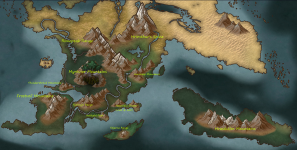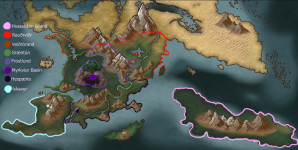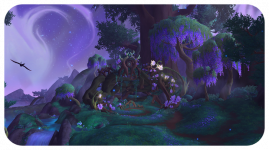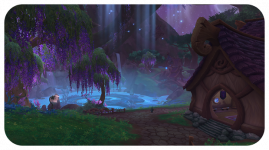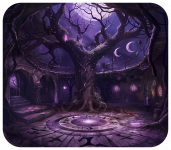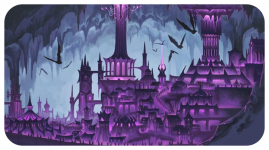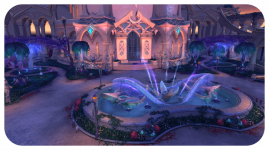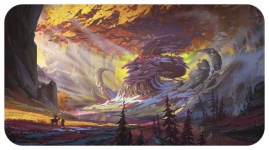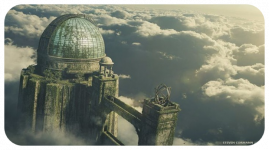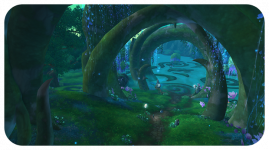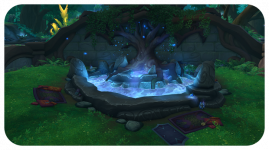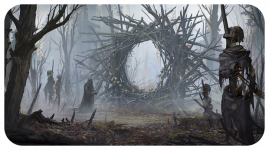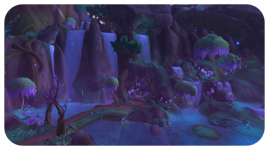Around three million miles of forests surrounding the mountain range are influenced by
Ældrassil, though such influence is weaker once one leaves the mountains. There are three small settlements, one north, one southwest and one southeast, each populated by the modern day descendents of what many believe were the first humans. They are, presently, subjugated by the Æld'Norai and live as vassals serving them. Their lives are, comparably, bleak. The forests are dark and dense, with outsiders describing them as dangerous places that ought to be feared and given a wide berth by travelers.

Large, densely forested, contains many rivers and lakes, ~540,000 mi²
Græntún is the largest and eldest of the Fælniri settlements, housing both their primary capital and the majority of its citizenry.
Capital: Rømskog ~513 mi²
Rømskog, erected slightly north of the Myrkvior range and along the banks of the largest lake in the region, serves as something of a capital for the Fælnir humans. And though it houses many more people than Ælfiríki, it is not anywhere so grand. Built primarily out of wood, much of the architecture is adorned with traditional carvings depicting flowers alongside charming woodland creatures, and most are painted lively colors in direct juxtaposition to the dark forests around them.
With its residential areas primarily on the outskirts, the heart of the city is a lively market district along the docks; most of the city's essential buildings lie between there and the largely residential outskirts. Rømskog's primary products exported to Ælfiríki are fish from the lake and wood harvested from the miraculously fast growing trees.

Medium, alpine settlement, ~174,000 mi²
From the edges of the southeastern Myrkvior outer forests up into the mountains themselves.
Capital: Iskrona ~328 mi²
Not all too much smaller than Rømskog, Iskrona is built up a ways into the southeastern part of the Myrkvior mountains. The boreal mountain climes may be harsh, but Iskrona's people believe that such conditions have made them strong. To express their perceived strength, the town's architecture is sturdy, composed of stone and often brutal in aesthetic. Further, the mages of the village have carved intricate runes into everything, utilizing them for a variety of enchantments as well as simple aesthetics.
Iskrona's population spends most of their time in the nearby quarry or hunting and are often lauded for the quality of their leather and stonework.
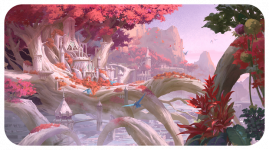
Large, red aspen forest settlement, ~ 403,230 mi²
Though quite spacious, Rauðrviðr's population is on the low end, almost entirely concentrated in the capital and nigh deserted near the Arcanis border aside from military encampments.
Capital: Rauðrót ~415 mi²
Surrounded on three sides by lake Vínvatna, Rauðrót is a fairly secluded city whose Fælnir populace has grown reliant upon the lake's bounty. Rauðrót is a layered city; it houses the second highest Æld'Norai population outside of the basin itself, and they live up within the boughs of a massive, pale tree with crimson leaves. The Ælves of Rauðrót live in similar luxury to their basin-dwelling counterparts, though there is a much higher military presence within due to its location being closer to the border and the fact that it lacks the protections provided by the Myrkvior mountains. Notably, however, the Æld'Norai of Rauðrót grow elaborate vineyards within the confines of the city's boughs, and the wine they produce is considered the finest within Ælheim.
The Fælnir live beneath them along the lake's shore, and their portion of city's overall design was influenced by the Fælnir capital of Rømskog. For this reason, it possesses a similar layout and they produce similar products, though the fish who live within Vínvatna are unique. Each possessing scales red in hue, they are particularly delicious and seen as delicacies to both the Fælnir and the Æld'Norai above.
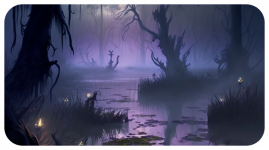
Medium, cold wetland settlement, ~ 310,000 mi²
100,000 mi² stemming from the capital are Hesperide’s Grove
The smallest of the major Fælniri settlements, Hesperia lies to the southwest, built deep into a cold, tenebrous bog. While one may not think this would be a good place to settle, it was founded by notorious witch and Æcturnis, Hesperide fyn'Seiðr Maebh. She absolutely adored these dark wetlands and claimed them as her Grove. In order to craft the Grove of her dreams, she also required quite a bit of manpower-- as such, she collected many human slaves, recruited other Æcturnis to her cause, and over the course of a few thousand years, that population grew to what it is today.
Capital: Thokkmyrr ~266 mi²
Taking advantage of the many Marshlog trees in the area, Hespæride and fellow Æcturnis of her conclave grew or carved all of Hespæria's buildings out of them, thus granting the towns within stable, livable architecture. Thokmyrr is the largest of such settlements. Being the oldest city, it is also the most gorgeous, with each of the structures lovingly carved or grown and adorned with plantlife or intricate runework. Many of the other towns in Hesperia take after Thokmyrr's architectural design.
The denizens of Hespæria at large and Thokkmyrr in particular are the most academic of the Fælniri settlements and, coveting the arcane, Hespæride herself will often convince, or send others in her stead to do so, those with arcane promise to come live there. For this reason, the town is a treasure trove of knowledge, and even has two major libraries, one public and one private, that rival those in Ælheim's capital. One will also find many consummate practitioners of every Practice within Hesperia.

Large, cold mountains, freljord and boreal forests, ~ 426,000 mi²
Similar in scale to Rauðrviðr, Iskavyr has a lower Ælven population and a higher concentration of Fælnir. While most of the population of Fælnir are concentrated near the capital and the nearest coast, the Æld'Norai who do call Iskavyr home are more scattered. Those who prefer the frigid beauty of the fjords tend to be those who enjoy their isolation, though there are a handful of lively communities as well.
Capital: Nýrthalas ~225 mi²
Nestled into a valley of the Frostveil mountains, Nýrthalas is a hidden gem amongst the ice floes of Iskavyr. Despite the overwhelming majority of the city's population being Fælnir, the capital's center remains a bastion of Ælven beauty with regards to its icebound architecture. As one gets farther from the city's Ælven roots, however, the buildings gradually bleed into the more rustic constructions more often built by Fælnir hands.
Nýrthalas is laid out along the coast of Iskavyr’s largest fjord, with the fjord’s mouth to the ocean opening westward. The smaller yet grander Ælven district is erected on the northern fourth of its coast and is connected to the market district, roughly equal in size. The markets serve as a buffer between the Ælven and larger Fælnir counterpart that run against the southern coast.
Those who call Nýrthalas home are an especially hardy sort, with strong hunters and fisherman being necessary to sustain the human population. And though the Æld'Norai rely primarily on their greenhouses for produce, many also enjoy hunting for sport, be their targets beast or man. In both cultures, strength and endurance are valued slightly higher than it is elsewhere in Ælheim.

An old warfield, scorched forests, ~160,000 mi²
The site of a historical battle, Veiðrbrand is now a scorched badlands. While it would be theoretically possible to regrow the dense forests that once grew here, the Æld'Norai have deemed it not worth the effort in part due to the fiery Luxium elementals and other warped monsters that took over the territory in the aftermath. Rather, this part of Ælheim is, in the present, used by many to practice more destructive magics, host all manner of magical experiments, host mock battles, and by adventurers of all stripes set out to test their mettle.



